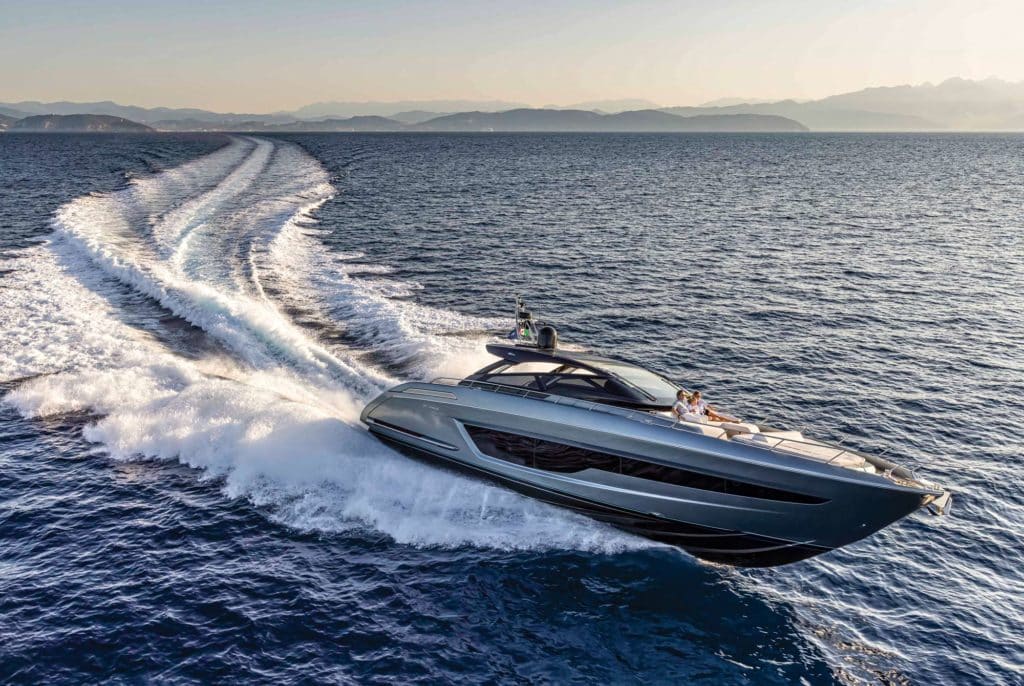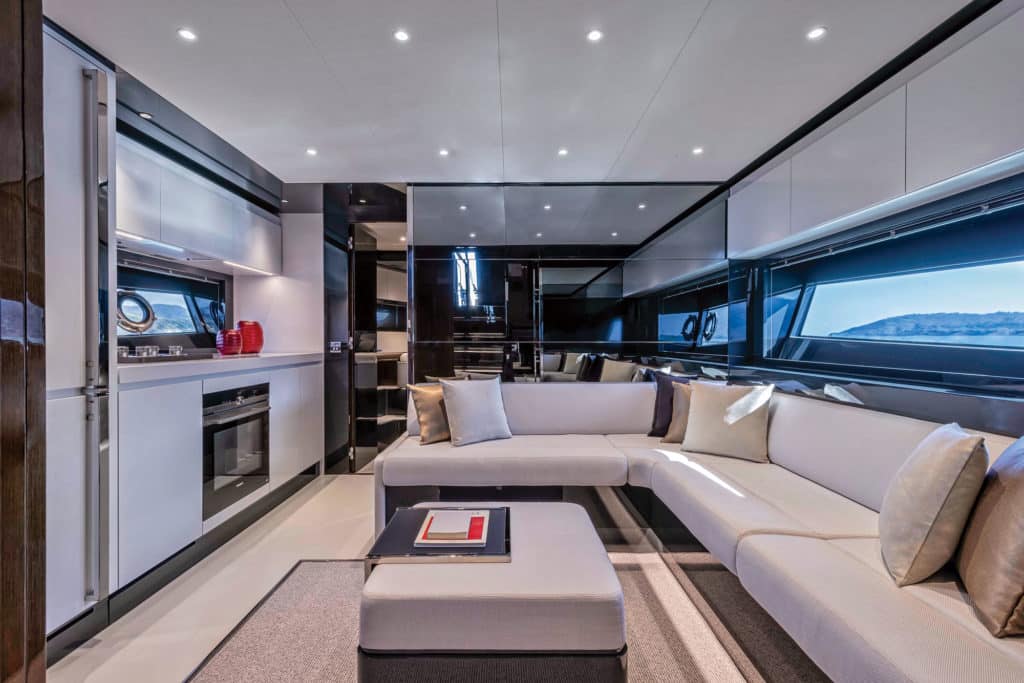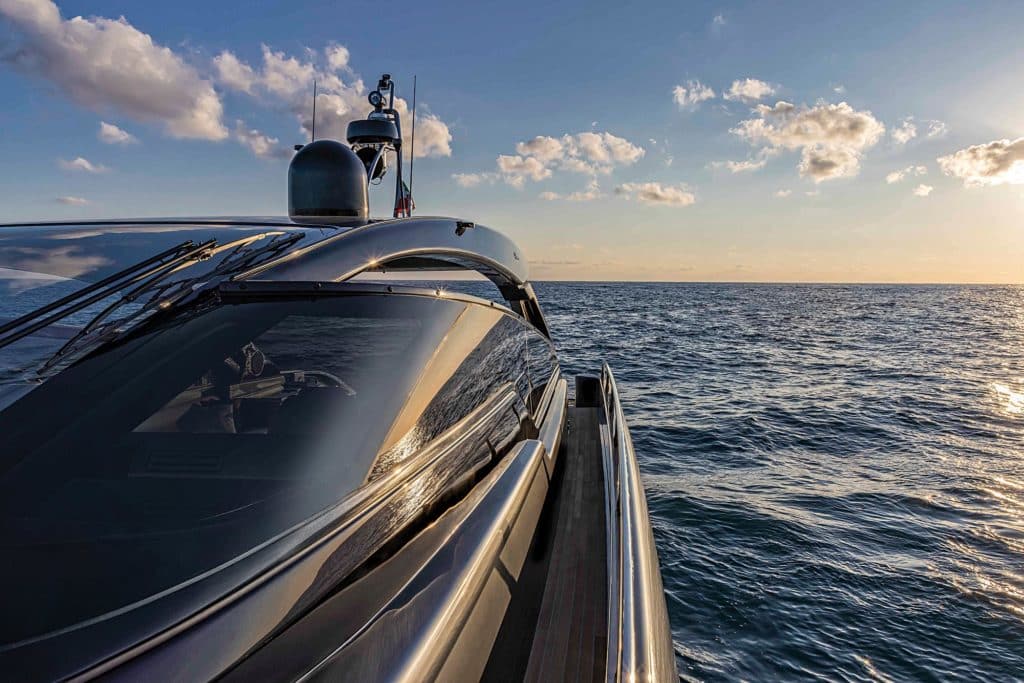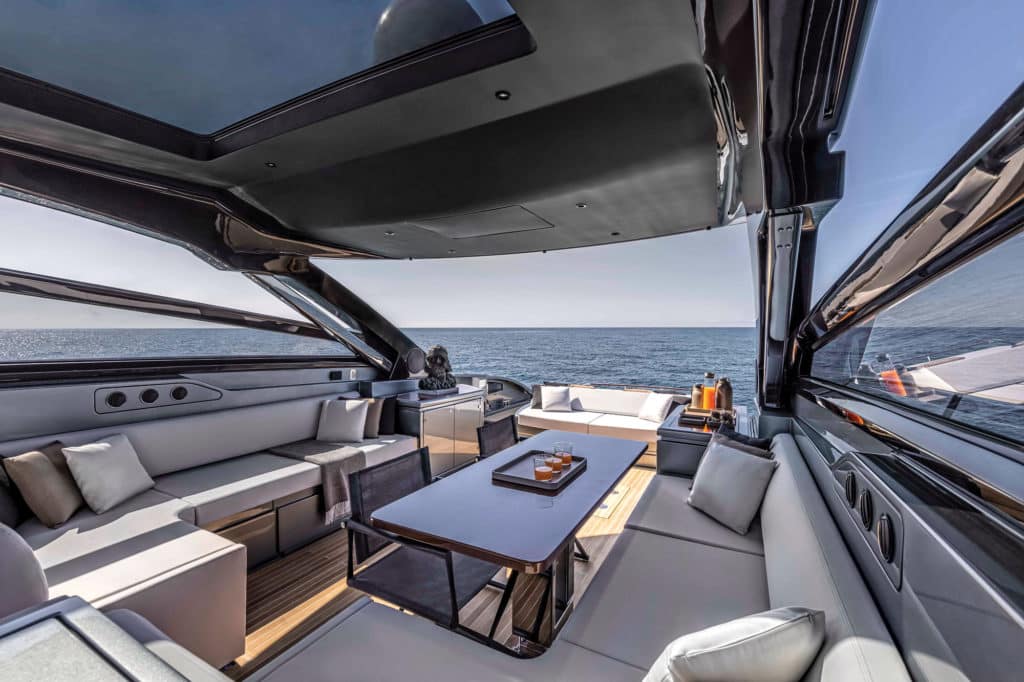
This latest creation is not Riva’s first Diable, the French word for “devil.” There was one predecessor: the Riva 50 Diable. A forerunner of the 51 Turborosso, the old Diable sports cruiser was in production from 1984 to 1989. Reflecting the styles of the times, it had a chunky, angular design with a squared-off transom and an arch mast. Riva built 31 hulls. One of them was the first Riva that I ever went aboard.
That was a different experience than going aboard today’s Riva 68 Diable, which is the biggest model to be built at Riva’s Sarnico headquarters on Italy’s Lake Iseo. Hull No. 1 has a modern, shark-gray metallic hull and cockpit moldings, a bright black-metallic superstructure, and a jaunty Riva-blue boot top. It’s a popular Riva scheme, although plenty of other color combinations are possible.
The hardtop is mostly carbon fiber, has a sunroof, and covers the forward half of the cockpit. For air circulation, there are air gaps between the top of the wraparound windshield and the roof section. There’s also a double-height windshield and a reverse-rake corner forward, where the windshield meets the deck. All these features also help to elongate the 68 Diable’s profile.
A pantograph-framed canvas awning protects most of the aft deck when desired. The whole space forms one big, open main-deck lounge, effectively seamless from the swim platform through to the helm console. As with the smaller Dolceriva and Rivale hardtops, the 68 Diable incorporates air-conditioning ducts, but there’s still plenty of headroom beneath—at least 6 feet, 6 inches. The cockpit furniture that isn’t optional is symmetrical on each side of a central corridor. Two L-shaped sofas extend along each side, with a dining table to port (this table could be specified to starboard instead, or on both sides). On Hull No. 1, this table is mahogany and inlaid with the Riva logo. It’s on a pedestal than can rise or drop at the flick of a switch, creating a day bed. A pop-up TV is abaft the observer bench to starboard.

The foredeck has several sofas and sun-lounging space. There’s another sofa at the transom, as well as a sun pad atop the tender garage, which accommodates a Williams Sportjet 345 and at least one Seabob. The hydraulic swim platform drops down on a slope and reveals more steps for water access. Several other current Rivas provide the same neat solution.
Standard in the engine room are twin 1,550 hp MAN V-12 diesels, which Riva says will deliver a top speed around 37 knots and a 33-knot fast cruise. The yacht I got aboard had the bigger 1,650 hp MAN V-12 motors, which topped out comfortably at just over 38 knots with a heavy load during my time aboard in September. Riva quotes a 40-knot maximum with these engines at one-third load.
At a fast cruise of around 34 knots, and with those diesels humming contentedly at around 2,000 rpm, fuel burn was 132 gallons per hour, which equates to a cruising time of 7.6 hours and a range of almost 260 nautical miles. Drop the engines down 400 rpm and level out at 26 knots, and that range spins out by another 50 nautical miles, adding two hours to the total run time.

The driving position is great. The helm console has a Simrad Command platform. Owners can choose a single 16-inch multifunction display or an optional second screen, as was aboard this 68 Diable. All the engine data is well-presented on a wide-screen display from Boening.
Handling is as responsive and precise as it can be aboard a machine that, fully ladened, weighs in at almost 100,000 pounds. This hull had the optional Seakeeper NG9 gyrostabilizer in standby mode during speed runs but left the Humphree dynamic trim system active. Happily, the 68 Diable also came with the optional Xenta joystick controls, which, in addition to easing dockside maneuvering, make for easy twist-of-the-wrist course adjustments when cruising. The optional dynamic-positioning system also makes station-keeping a cinch alongside a fuel dock or while waiting for a bridge to open.
Riva decor is always a treat. There are varnished mahogany highlights, polished stainless steel, stitched leatherwork and more: The looped handles on the stateroom doors have been used aboard Riva cruisers for something like 50 years. Even the inside of Riva’s closets are high-gloss veneers.
The standard veneers throughout the yacht are reconstructed—or “rigatoni”—wenge, which look fabulous, but the upgraded rosewood has a more luxurious striped grain and seemingly even more depth to the varnish. If you prefer a lighter and brighter vibe, there’s also a gray-and-white matte oak alternative.

Belowdecks are an amidships galley to port with a fridge/freezer, cooktop and dishwasher, as well as a lounge with a dinette to starboard. There are three staterooms with hullside-window views. The owner’s stateroom is down a few steps and aft with a forward-facing double berth and an en suite head to port, abaft a sliding door with separate stalls for the toilet and shower. The VIP stateroom is in the bow with an en suite head. A day head to starboard serves the twin-berth guest stateroom. There is also crew space for one, with a separate shower stall, accessed beneath the cockpit sofa.
Riva’s 68 Diable is a feisty addition to the builder’s Open portfolio, incorporating the best of what the brand is known for while adding something new too.
Sound Investment
Riva has striven over the years to reduce sound and vibration levels on all its yachts. At around 30 knots, the 68 Diable’s decibels just about everywhere rarely get above the mid-80 range, about the same level of noise as a lawn mower. At a 10-knot chug, I measured 74 decibels at the helm and 70 to 72 decibels in the master stateroom. That’s the equivalent of a hair dryer or dishwasher.
Bigger Models
While the smaller Rivas are built well inland on Lake Iseo in Northern Italy, the bigger Rivas—from the 76 Perseo Super up to the 110 Dolcevita—are fitted out at Riva’s facility on the west coast in La Spezia. The all-new composite trideck Riva 130, the first of the models expected to launch in 2022, and all the biggest metal Rivas are built at Riva Superyachts in Ancona.
Stirred, Not Shaken
The 68 Diable has custom racking and drawer inserts for cutlery, chinaware, glassware, wine bottles and galley utensils. All stow beautifully. My favorite example aboard the 68 Diable is in the cockpit. Open a cupboard door, and there are two Perspex pullout shelves; the lower one houses a half-dozen cocktail glasses, and the upper has a polished, stainless-steel Alessi cocktail shaker and accessories.
Take the next step: riva-yacht.com









